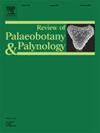Late Holocene vegetation dynamics and climate variations through pollen analysis of sediments from Lake Sülük (Çorum, Türkiye)
IF 1.7
3区 地球科学
Q2 PALEONTOLOGY
引用次数: 0
Abstract
The sediment core from Lake Sülük provides evidence of significant vegetation and environmental changes during the late Holocene, covering the last 2170 yr BP. The period of 2170–1650 yr BP revealed the dominance of Pinus and Asteraceae-Cichorioideae, indicating cooler, drier conditions with open pine forests and herbaceous understories, particularly during the Hellenistic-Galatian and early Roman periods. During the same period, an increase in the Pollen Disturbance Index (PDI) indicates long-term local grazing or breeding activities. The pronounced increase in Pinus pollen between 1300 and 1150 yr BP suggested the expansion of pine forests, which was likely influenced by favorable climatic conditions or changes in land use. The rising levels of Artemisia and Poaceae indicate mixed pastoral and agricultural activities. Pinus dominance peaked during the Seljuk Empire. In the late Antiquity Period, other woody species, such as Alnus, Carpinus betulus, and deciduous Quercus, expanded locally, while the rise of Ranunculus species highlights their resilience to arid Mediterranean conditions. After 610 yr BP, the abundance of Pinus declined, allowing other arboreal species, particularly deciduous Quercus and Juglans, to thrive notably during the Ottoman Empire. The presence of cultivated trees, including Juglans, Vitis, and Olea europaea, confirms extensive agricultural activities during the Ottoman period, reflecting human influence on the vegetation. Mixed deciduous and coniferous forests dominated the surrounding mountains, whereas riparian zones were characterized by Populus and Salix. The interaction between natural ecosystems and human settlements is evident, with vegetation shifts driven by both climatic changes and human activities.
求助全文
约1分钟内获得全文
求助全文
来源期刊
CiteScore
3.50
自引率
21.10%
发文量
149
审稿时长
6 months
期刊介绍:
The Review of Palaeobotany and Palynology is an international journal for articles in all fields of palaeobotany and palynology dealing with all groups, ranging from marine palynomorphs to higher land plants. Original contributions and comprehensive review papers should appeal to an international audience. Typical topics include but are not restricted to systematics, evolution, palaeobiology, palaeoecology, biostratigraphy, biochronology, palaeoclimatology, paleogeography, taphonomy, palaeoenvironmental reconstructions, vegetation history, and practical applications of palaeobotany and palynology, e.g. in coal and petroleum geology and archaeology. The journal especially encourages the publication of articles in which palaeobotany and palynology are applied for solving fundamental geological and biological problems as well as innovative and interdisciplinary approaches.

 求助内容:
求助内容: 应助结果提醒方式:
应助结果提醒方式:


